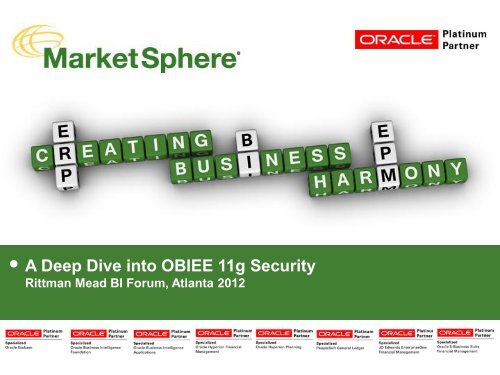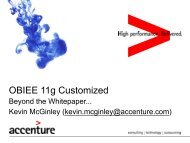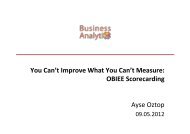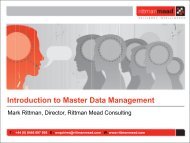A Deep Dive into OBIEE 11g Security - Rittman Mead Consulting
A Deep Dive into OBIEE 11g Security - Rittman Mead Consulting
A Deep Dive into OBIEE 11g Security - Rittman Mead Consulting
You also want an ePaper? Increase the reach of your titles
YUMPU automatically turns print PDFs into web optimized ePapers that Google loves.
A <strong>Deep</strong> <strong>Dive</strong> <strong>into</strong> <strong>OBIEE</strong> <strong>11g</strong> <strong>Security</strong><br />
<strong>Rittman</strong> <strong>Mead</strong> BI Forum, Atlanta 2012<br />
© 2012 MarketSphere <strong>Consulting</strong>, LLC
About the Speaker<br />
Ramke Ramakrishnan<br />
Practice Director - Business Intelligence & EPM<br />
MarketSphere <strong>Consulting</strong><br />
ramke.ramakrishnan@marketsphere.com<br />
www.marketsphere.com<br />
• Performing lead architect and technical leadership roles for over 15 years on<br />
Business Intelligence by effectively managing the project team and the<br />
business customer expectations.<br />
• Continuously demonstrated hands-on capabilities in the configuration of robust<br />
Oracle database and BI architectures, Oracle’s Essbase infrastructure and<br />
large scale Business Intelligence Reporting, OBI Applications and EPM<br />
implementations.<br />
• Key contributor for Business Analytics and Enterprise Reporting by integrating<br />
various applications systems <strong>into</strong> analytics to empower business customers,<br />
executives and end-users.<br />
• Oracle Certified in DBA, Essbase, BI Foundation Suite and OBI Applications;<br />
• Active member and designated Deputy CTO (DCTO) on Oracle Business<br />
Intelligence Investment Partner Community (IPC)<br />
© 2012 MarketSphere <strong>Consulting</strong>, LLC
About MarketSphere<br />
Business Overview<br />
Strategic advisory and technology experts to help you deliver integrated<br />
ERP, BI and EPM solutions to optimize business performance.<br />
• Our focus is on solving complex business challenges and strategic opportunities for<br />
Fortune 500 and emerging, high-growth companies<br />
• Services delivered out of eleven formal market locations throughout the United States<br />
• In 2011, engaged by more than 260 clients on over 400 projects<br />
© 2012 MarketSphere <strong>Consulting</strong>, LLC<br />
Atlanta<br />
Chicago<br />
Dallas<br />
Houston<br />
Indianapolis<br />
Kansas City<br />
New York<br />
Omaha<br />
Philadelphia<br />
Pittsburgh<br />
St. Louis
About MarketSphere<br />
Creating Business Harmony<br />
© 2012 MarketSphere <strong>Consulting</strong>, LLC
A <strong>Deep</strong> <strong>Dive</strong> <strong>into</strong> <strong>OBIEE</strong> <strong>11g</strong> <strong>Security</strong><br />
Agenda<br />
1<br />
2<br />
3<br />
4<br />
5<br />
6<br />
7<br />
8<br />
9<br />
10<br />
Introduction<br />
© 2012 MarketSphere <strong>Consulting</strong>, LLC<br />
<strong>OBIEE</strong> <strong>11g</strong> <strong>Security</strong> Controls<br />
Authentication<br />
Authorization<br />
Content <strong>Security</strong><br />
User GUIDs<br />
Multiple Authentication Providers<br />
Row Level <strong>Security</strong><br />
<strong>Security</strong> Store Migration<br />
Single Sign-On (SSO)
Introduction<br />
<strong>OBIEE</strong> <strong>Security</strong> Overview<br />
• <strong>OBIEE</strong> <strong>11g</strong> provides a scalable default security mechanism to manage users and groups, permission<br />
grants and credentials through native and external authentication providers.<br />
• <strong>OBIEE</strong> <strong>11g</strong> implements Fusion Middleware stack leveraging common security architecture. Also<br />
introduces a significant change in both the approach and architecture of <strong>OBIEE</strong> for authentication ,<br />
provisioning and authorization of users<br />
• <strong>OBIEE</strong> <strong>11g</strong> uses the architectural components of Oracle Fusion Middleware (FMW) called Oracle<br />
Platform <strong>Security</strong> Services (OPSS), the underlying security platform that provides security. The OPSS<br />
components listed provides a common security framework across many Oracle applications that runs<br />
on FMW including <strong>OBIEE</strong> <strong>11g</strong> and Fusion Applications<br />
• <strong>OBIEE</strong> <strong>11g</strong> delegates security to OPSS which uses features such as Credential Store Framework,<br />
Policy Store and identify store through WLS authenticators to provide security to the Oracle BI system.<br />
© 2012 MarketSphere <strong>Consulting</strong>, LLC
<strong>OBIEE</strong> <strong>Security</strong> Architecture<br />
Application Server - Core Components<br />
BI Publisher<br />
Analytics<br />
OBI Presentation<br />
Server<br />
Scheduler<br />
© 2012 MarketSphere <strong>Consulting</strong>, LLC<br />
Oracle Weblogic Server<br />
<strong>Security</strong> Service<br />
OWSM<br />
OBI Server<br />
OPSS<br />
Identity Store<br />
Policy Store<br />
Credential Store<br />
LDAP: WLS,<br />
OID, AD etc.,<br />
LDAP (OID)<br />
or File Based<br />
MDS<br />
Inter-process<br />
communication via<br />
System User Connection
<strong>OBIEE</strong> <strong>Security</strong> Architecture<br />
Fusion Middleware Model<br />
Application Server (weblogic domain)<br />
© 2012 MarketSphere <strong>Consulting</strong>, LLC<br />
<strong>Security</strong> Realm<br />
Identity<br />
Store<br />
Credential<br />
Store<br />
Policy<br />
Store<br />
OPSS<br />
Admin Server<br />
BI Middleware<br />
Analytics<br />
BI Publisher<br />
Managed Server<br />
Oracle BI Server<br />
Oracle BI<br />
Presentation<br />
Services
<strong>OBIEE</strong> <strong>Security</strong> Controls<br />
OPSS and OWSM components<br />
• <strong>OBIEE</strong> <strong>11g</strong> security is more aligned with the Oracle middleware and fusion applications architecture that<br />
includes components of OPSS, OWSM services as part of the security controls.<br />
• Oracle Platform <strong>Security</strong> Services (OPSS) consists of<br />
o An embedded LDAP “Identity Store” to store users<br />
and groups which can also be configured to use<br />
external stores and/or providers such as MSAD and<br />
other authenticators<br />
o A “Policy Store” container that consists of application<br />
roles, application policies and the permissions, grants<br />
information. By default, it is stored in a file called<br />
system-jazn-data.xml but can be redirected to an LDAP<br />
or file-based policy store. Oracle Fusion Middleware<br />
(FMW) concept of Application roles and policies is<br />
utilized for assignment of permissions and privileges<br />
o A “Credential Store” file system container that stores user and system credentials for inter process<br />
communication which can be also be configured to use external providers. The credential store<br />
holds BISystemUser, OracleSystemUser credentials, RPD, SSL, Web Services credentials and<br />
certificates in cwallet.sso file at the weblogic domain level<br />
• Oracle Web Services Manager (OWSM) integrated with WLS EM Console provides the management<br />
and securing of web services through administration of policies<br />
• Some of the basic concepts of presentation object-level and data-level security remain the same in <strong>11g</strong><br />
© 2012 MarketSphere <strong>Consulting</strong>, LLC
System Users<br />
Inter BI Component communication<br />
• The key user accounts that is added to the Credential Store by default as part of the<br />
<strong>OBIEE</strong> <strong>11g</strong> installation are BISystemUser and OracleSystemUser<br />
BISystemUser<br />
o primarily used for inter-bi-component communication by default referenced via<br />
WLS Default Authenticator or through external authenticator<br />
o acts as user for Impersonation<br />
o credentials is stored in the Credential Store under oracle.bi.system – system.user<br />
o by default BISystemUser is a member of an LDAP Group called ‘Administrators’<br />
which is assigned to the Weblogic Global Admin Role. BISystemUser is also<br />
automatically assigned to BISystem application role<br />
OracleSystemUser<br />
o Utilized by OWSM<br />
o by default called OracleSystemUser and a member of the OracleSystemGroup.<br />
The User name can be changed, but need to follow FMW documentation for<br />
detailed steps. Also, by default it is created and referenced via the Default<br />
Authenticator and can be changed to external authenticator<br />
© 2012 MarketSphere <strong>Consulting</strong>, LLC
<strong>OBIEE</strong> <strong>11g</strong> <strong>Security</strong> Components<br />
<strong>Security</strong> Administration<br />
Oracle Weblogic Server<br />
Admin Console<br />
WLS Embedded<br />
LDAP Server<br />
(Users & Groups)<br />
© 2012 MarketSphere <strong>Consulting</strong>, LLC<br />
Oracle Enterprise Manager<br />
Fusion Middleware Control<br />
Credential Store<br />
(Credentials)<br />
Policy Store<br />
(Application Roles)<br />
Oracle BI Admin<br />
Tool<br />
Repository (RPD)<br />
(Permissions)<br />
Oracle BI Presentation<br />
Services Admin<br />
Presentation<br />
Catalog<br />
(Permissions)<br />
• WebLogic Server Admin Server (LDAP Server, <strong>Security</strong> Providers)<br />
• Fusion Middleware Control (Application Roles)<br />
• BI Administration tool (subject-area, and row-level security)<br />
• Catalog Manager and Presentation Services Catalog View (object permissions)<br />
• Présentation Services Administration Page (Permissions to End-User Présentation)
Authentication<br />
<strong>OBIEE</strong> Identify Management<br />
• WebLogic provides the default authentication provider for <strong>OBIEE</strong> <strong>11g</strong>. The default<br />
authentication provider accesses user and group information stored in the LDAP server<br />
embedded in the Oracle Business Intelligence's Oracle WebLogic Server domain.<br />
• Users are authenticated by the WebLogic server<br />
based on the credentials defined in the embedded<br />
WebLogic LDAP server.<br />
• WebLogic also supports integration with other<br />
identity management products and/or alternate<br />
directory (also known as Authentication providers)<br />
• Users, Groups and related attributes can be<br />
managed and administered in WebLogic LDAP<br />
server or other external authentication providers and<br />
retrieved during the authentication process<br />
• With direct integration of OPSS to security stores and authentication providers, the<br />
details of users and their application roles will automatically inherited and shown in the<br />
Identity Manager within the <strong>OBIEE</strong> Administration tool though not editable. Hence, BI<br />
server does not require the use of initialization block in the repository for authentication<br />
(not recommended for <strong>11g</strong>) as it is now embedded in the WebLogic Server.<br />
• Unlike 10g, the entire RPD is encrypted in <strong>11g</strong> and will require repository password to<br />
access RPD through the <strong>OBIEE</strong> Administration Client tool.<br />
© 2012 MarketSphere <strong>Consulting</strong>, LLC
Authorization<br />
Privileges and Permissions Management<br />
• Application Roles and Policies are the key<br />
components for defining authorization for <strong>OBIEE</strong><br />
<strong>11g</strong> and it comes with pre-defined set of groups,<br />
application roles and application policies.<br />
• WLS provides a default policy store provider, which<br />
is accessed through Fusion Middleware Control<br />
allows to create and maintain application roles,<br />
assign policies to the roles and then map external<br />
LDAP authenticator groups to these roles<br />
• Application roles allows the artifacts of a business<br />
intelligence system to be easily moved between<br />
environments as no change to the security policy is<br />
needed and all that is required is to assign the<br />
Application roles to the users and groups available<br />
in the target environment<br />
• An application role typically specific to a given<br />
application can be mapped to other application<br />
roles defined in the same application scope as well<br />
as to the enterprise users or groups, and they are<br />
used in authorization decisions.<br />
© 2012 MarketSphere <strong>Consulting</strong>, LLC
Authorization<br />
Privileges and Permissions Management<br />
• Within the context of <strong>OBIEE</strong>, the “Application roles” replaces “Groups” in <strong>OBIEE</strong>10g. In<br />
<strong>OBIEE</strong> 10g, any changes to corporate LDAP groups require a corresponding change to<br />
Groups and their permission assignment. In <strong>OBIEE</strong> <strong>11g</strong>, Application roles provide a<br />
logical mapping between permission definitions and corporate LDAP Groups.<br />
Permissions are defined at Application Role level and changes to LDAP groups just<br />
require a reassignment of the Group to the Application Roles. The same applies for web<br />
catalog objects as well.<br />
• The default Application Roles available as<br />
default are BIAdministrator, BISystem,<br />
BIConsumer and BIAuthor.<br />
• WLS admin user (usually weblogic) specified<br />
during installation assigned to a group called<br />
“BIAdministrators” which has the BIAdministrator<br />
application role granted to it. There are also<br />
groups called BIAuthors and BIConsumers<br />
which have the BIAuthor and BIConsumer<br />
application roles granted, and provides the<br />
ability to add new users, groups and application<br />
roles<br />
• Application policies are the authorization policies that an application relies for controlling<br />
access to its resources. An Application Role is defined and governed by the Application<br />
Policy<br />
© 2012 MarketSphere <strong>Consulting</strong>, LLC
Content <strong>Security</strong><br />
Administering Object Level Permissions<br />
• Restriction of the content and presentation is typically<br />
managed within the combination of RPD, Presentation<br />
Administration interface and catalog manager<br />
• To restrict to have access to certain presentation catalog<br />
objects such as subject area, presentation folders and<br />
columns in the repository, you modify the permissions to<br />
the application roles assigned to the user at the <strong>OBIEE</strong><br />
repository<br />
• In case of situations where you want to override the<br />
permission only at the creation of the analysis/report i.e.,<br />
you want to restrict the users to use specific presentation<br />
objects in their own analysis but can view the data from a<br />
shared analysis/report, you have to administer the<br />
privileges at the catalog and/or presentation services.<br />
Access to certain features and functions of the <strong>OBIEE</strong><br />
presentation is also managed and administered at the<br />
presentation services level<br />
• Permissions to the catalog objects such as dashboards<br />
and other presentation objects and folder permissions are<br />
managed via the catalog manager to individual users,<br />
application roles as well as catalog groups (to support<br />
backward compatibility for 10g)<br />
© 2012 MarketSphere <strong>Consulting</strong>, LLC
User GUIDs<br />
Synchronization and Refresh<br />
• In <strong>OBIEE</strong> <strong>11g</strong>, Users are uniquely identified by Global Unique Identifiers (GUIDs), an<br />
identifier that is completely unique to a given user<br />
• GUIDs provides greater level of security to ensure that both the metadata and data is<br />
securely provisioned for a specific user that is added to the BI System<br />
• GUIDs are likely to change and goes “out of sync” and prohibits login to the Presentation<br />
as the user gets added and/or removed or during migration between environments or<br />
migration of security store from weblogic LDAP to external authenticators<br />
• The synchronization of GUIDs can be fixed using “Refresh / Regenerating GUIDs” and<br />
the key steps includes:<br />
o Change the parameter FMW_UPDATE_ROLE_AND_USER_REF_GUIDS = YES in the NQSConfig.INI<br />
o Add the below tag to the Catalog section in the instance config.xml<br />
<br />
false<br />
UpdateAndExit<br />
<br />
o Restart the BI System components using opmnctl with stopall and startall parameters<br />
o Reset the parameter FMW_UPDATE_ROLE_AND_USER_REF_GUIDS = NO in the NQSConfig.INI<br />
o Delete or Comment out the entry UpdateAndExit<br />
in the instance config.xml<br />
o Restart the BI System as above<br />
© 2012 MarketSphere <strong>Consulting</strong>, LLC<br />
16
Multiple Authentication Providers<br />
Virtualize Identity<br />
• <strong>OBIEE</strong> supports adding multiple identify providers for authentication within the Weblogic<br />
Admin Console<br />
• The default embedded weblogic providers are “DefaultAuthenticator” and<br />
“DefaultIdentifyAsserter”<br />
• Providers support for<br />
o Users and Groups in LDAP<br />
o Users and Groups in Database<br />
o Users in LDAP and Groups in Database using new provider<br />
“BISQLGroupProvider”<br />
• When multiple Identity Providers are used, set the “virtualize = true” custom property within FMW<br />
Control<br />
• Always keep the “BISystemUser” in the local weblogic LDAP store and not to the external LDAP<br />
provider as suggested in the documentation. Having the BISystemUser locally will help us to manage<br />
and adminster the Oracle BI even when the external LDAP is unavailable<br />
© 2012 MarketSphere <strong>Consulting</strong>, LLC<br />
17
Row-Level <strong>Security</strong><br />
Securing Data Access<br />
• Row-Level security in <strong>OBIEE</strong> provides the ability to restrict<br />
and/or filter data so that different sets of data is presented<br />
to the end users for the same set of dashboards and<br />
reports<br />
• The context of Row-Level security typically applied<br />
automatically at the BI Server and/or at the database level<br />
based on the user credentials and not in the<br />
Analysis/Report by itself<br />
• Restriction of data at the database level based on the users<br />
are typically handled by leveraging the database features.<br />
In case of Oracle, Virtual Private Database can be used<br />
and for Essbase, security filter can be applied in EAS and<br />
provisioning in shared services. For other databases, native<br />
security features can be leveraged.<br />
• For row-level security, the security filter is defined at the<br />
application role in the Admin client Identity Manager<br />
• In case of multiple values to be used in the filter, the rowwise<br />
initialization variable can be used to store multiple<br />
values<br />
• Except for the <strong>11g</strong> terminology and mapping of application<br />
roles, the row-level security is similar to how it works in 10g<br />
© 2012 MarketSphere <strong>Consulting</strong>, LLC<br />
Create Application Role in EM<br />
& Assign User/Group to that<br />
Role<br />
Create Table in Database to<br />
store Row-Level <strong>Security</strong><br />
Attribute per User<br />
Create Session<br />
Initialization Block<br />
to initialize<br />
VARIABLE (Rowwise<br />
initialization<br />
& no caching)<br />
Add Data filter<br />
to the<br />
Application<br />
Role in Identity<br />
Manager using<br />
the session<br />
VARIABLE<br />
• Bring the Row-<br />
Level <strong>Security</strong><br />
table to the RPD<br />
and make it noncacheable<br />
• Define Physical<br />
Join with the<br />
Dimension table<br />
and add USER ID<br />
as an attribute to<br />
that Dimension in<br />
Logical Layer<br />
Add Data filter to<br />
the Application<br />
Role in Identity<br />
Manager using<br />
the USER<br />
Session Variable
<strong>Security</strong> Migration<br />
Identify Store Migration<br />
• With the revamped security architecture , the security migration in <strong>OBIEE</strong> <strong>11g</strong> will require<br />
lot more attention and considerations<br />
• For scope of security migration include the migration of Identify Store, Policy Store,<br />
Credential Store even though not all of them will require migration and may remain<br />
static/constant values across the environments<br />
• Migration of <strong>OBIEE</strong> security store supports both full and incremental migration. However,<br />
some of the security store such as policy store may not support a complete export/full<br />
migration<br />
• Identity Store can be migrated from the WLS<br />
admin console through the export/import interface<br />
in <strong>Security</strong> Realm . After the export the following<br />
files are created for migration.<br />
DefaultAuthenticator.dat<br />
DefaultCredentialMapper.dat<br />
exportIndex.dat<br />
XACMLAuthorizer.dat<br />
XACMLRoleMapper.dat<br />
Note: The roles migrated through this process are the policies specific to the Admin Server and not the application roles and policies<br />
© 2012 MarketSphere <strong>Consulting</strong>, LLC
<strong>Security</strong> Migration<br />
Policy Store Migration<br />
• Migrating Policy Stores/Application Roles will<br />
require WLST<br />
o Policy Store is nothing but a physical file that<br />
contains the Application Role, Applications<br />
Policies and their corresponding mapping to<br />
the authenticatorUsers and Groups.<br />
o It’s stored in system-jazn-data.xml under<br />
/middleware/user_projects/do<br />
mains/bifoundation_domain/config/fmwconfig<br />
o During migration, you copy the file to a<br />
temporary location in the target environment<br />
and run the Migrate<strong>Security</strong>Store WLST<br />
scripting method.<br />
o For incremental migration, createAppRole,<br />
grantAppRole commands can be applied to<br />
propagate the incremental changes from one<br />
environment to the other<br />
© 2012 MarketSphere <strong>Consulting</strong>, LLC<br />
Environment A<br />
(System-jaz-data.xml)<br />
migrate<strong>Security</strong>Store<br />
using<br />
(jps-config-policy.xml)<br />
Environment B<br />
(System-jaz-data.xml)
<strong>Security</strong> Migration<br />
Credential Store Migration<br />
• Migrating Credential Store can also be accomplished<br />
using WLST<br />
o Credential Store contains system credentials in<br />
an encrypted format inside a security file called<br />
cwallet.so<br />
o Prior to migration, we need to extract the full<br />
system credentials from the Credential Store<br />
using listCred method and recreate using<br />
createCred method.<br />
o Alternatively, we can do a full migration of the<br />
credential store using Migrate<strong>Security</strong>Store, it is<br />
generally not recommended unless you want to<br />
retain the same credentials for the<br />
oracle.bi.enterprise and oracle.bi.system entries<br />
• In addition to the manual approach of export/import of the security store content,<br />
weblogic also provides Weblogic Scripting Tool (WLST) interface for invoking through<br />
command line and automation. As an alternate, Java API interface using JMX bean<br />
scripting can also be utilized<br />
© 2012 MarketSphere <strong>Consulting</strong>, LLC<br />
Environment A<br />
(cwallet.so)<br />
listCred<br />
&<br />
createCred<br />
Environment B<br />
(cwallet.so)
Single Sign-On (SSO)<br />
Overview<br />
• Integrating a single sign-on (SSO) solution enables a<br />
user to log on (sign-on) and authenticated once and<br />
have seem less access to across all application<br />
including <strong>OBIEE</strong>.<br />
SSO Configuration for <strong>OBIEE</strong> include the following:<br />
• Configure Oracle Access Manager or Custom<br />
Solution (SiteMinder or Native Windows) as the SSO<br />
authentication provider<br />
• Configure the Web proxy to forward requests from the<br />
Oracle BI Presentation Server to the SSO provider<br />
• Configure a new authenticator for Oracle WebLogic<br />
Server<br />
• The Oracle WebLogic Server domain in which Oracle Business Intelligence is installed<br />
must be configured to use an Oracle Access Manager asserter (OAMIdentityAsserter).<br />
This feature uses the Oracle Access Manager authentication services and validates<br />
already-authenticated Oracle Access Manager users through a suitable token and creates<br />
a WebLogic-authenticated session. It also provides single sign-on between WebGate and<br />
portals. WebGate is a plug-in that intercepts Web resource (HTTP) requests and forwards<br />
them to the Access Server for authentication and authorization<br />
© 2012 MarketSphere <strong>Consulting</strong>, LLC
Single Sign-On (SSO)<br />
SSO Methods<br />
Enable Oracle Business Intelligence to accept SSO authentication from the security page<br />
in Enterprise Manager. The appropriate form of SSO is determined by the configuration<br />
settings made for the chosen SSO provider. If required, enter logon and logoff URLs for<br />
the configured SSO provider. The logoff URL (specified by the SSO provider) must be<br />
outside the domain<br />
Supported SSO Mechanisms<br />
FMW <strong>Security</strong>:<br />
• Oracle Access Manager (OAM) Asserter<br />
• Oracle Single Sign On (OSSO) Asserter<br />
• Weblogic Default Asserter (for Client Certificate Authentication)<br />
• Negotiate Identity Asserter (Kerberos - Windows Native Authentication without IIS)<br />
Other Authentication Methods:<br />
• SSO via http header or cookie<br />
• E-Business Suite ICX Cookie mechanism<br />
• Windows Authentication using IIS (uses http header)<br />
• Siteminder 6 via http header<br />
• Go URL parameters via get or post (using &NQUSER/&NQPASSWORD )<br />
© 2012 MarketSphere <strong>Consulting</strong>, LLC
Single Sign-On (SSO)<br />
Identify Providers and FMW Setup<br />
For SSO enablement, the order of authenticators has to be defined as follows:<br />
• LDAP Authenticator (sufficient)<br />
• SSO Asserter (required)<br />
• Embedded Weblogic LDAP (sufficient)<br />
LDAP authenticator is required for obtaining groups for users as well as for authentication<br />
for non-SSO access such as BI Office<br />
Enable the SSO through the FMW Control.<br />
© 2012 MarketSphere <strong>Consulting</strong>, LLC
Single Sign-On (SSO)<br />
<strong>OBIEE</strong> and WebCenter Integration<br />
• The integration uses the impersonate abilities of <strong>OBIEE</strong> to ensure reports and data are<br />
secured correctly.<br />
• The integration requires the same user name population across the Web Center and<br />
<strong>OBIEE</strong> for the integration to work. This can be achieved by sharing the same LDAP<br />
Authentication provider.<br />
• Create BIImpersonatorUser user & assign Impersonate policy to the user in <strong>OBIEE</strong><br />
• Create SOAP connection in Web Center through Mbean browser to connect to <strong>OBIEE</strong><br />
<strong>OBIEE</strong> Dashboard<br />
© 2012 MarketSphere <strong>Consulting</strong>, LLC
Single Sign-On (SSO)<br />
<strong>OBIEE</strong> and WebCenter Integration<br />
• The integration uses the impersonate abilities of <strong>OBIEE</strong> to ensure reports and data are<br />
secured correctly.<br />
• The integration requires the same user name population across the Web Center and<br />
<strong>OBIEE</strong> for the integration to work. This can be achieved by sharing the same LDAP<br />
Authentication provider.<br />
• Create BIImpersonatorUser user & assign Impersonate policy to the user in <strong>OBIEE</strong><br />
• Create SOAP connection in Web Center through Mbean browser to connect to <strong>OBIEE</strong><br />
© 2012 MarketSphere <strong>Consulting</strong>, LLC<br />
<strong>OBIEE</strong> Dashboard
Questions?<br />
© 2012 MarketSphere <strong>Consulting</strong>, LLC
© 2012 MarketSphere <strong>Consulting</strong>, LLC<br />
Ramke Ramakrishnan<br />
Practice Director, Oracle Business Intelligence<br />
ramke.ramakrishnan@marketsphere.com





